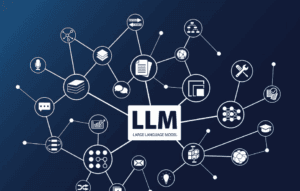Large Language Models (LLMs) are becoming a core driver of innovation in artificial intelligence, particularly in the field of Natural Language Processing (NLP). This article delves into the technical principles, latest development trends, challenges, and the value of LLMs across various industries.
I. Introduction to LLM and Fundamental Principles
1.1 Definition and Background of LLM
LLMs are deep learning-based models with billions of parameters, pre-trained on vast datasets to enable sophisticated language understanding and generation. These models learn extensive linguistic context and structure during pre-training, enhancing their performance in downstream tasks that require natural language understanding.
1.2 Transformer Architecture in LLMs
The Transformer model underpins LLMs and includes key components:
- Self-Attention Mechanism: Calculates the relationship between each word in the input sequence to capture context, significantly enhancing the quality of text generation.
- Multi-Head Attention: Uses multiple attention heads to capture different semantic levels in a sentence, greatly improving language comprehension.
- Residual Connections and Layer Normalization: These mechanisms help maintain gradient stability in deep networks, facilitating the training of extremely deep models.
The table below compares Transformer models with other NLP architectures, highlighting the substantial advantages in efficiency and performance.
| Model Type | Parameter Count | Parallelization Capability | Time Complexity | Application Scenario |
|---|---|---|---|---|
| RNN | Medium | Unsupported | O(n) | Sequence generation, time series prediction |
| CNN | High | Partially supported | O(log(n)) | Image recognition, text classification |
| Transformer | Very High | Fully supported | O(n^2) | NLP tasks, language generation |
II. Key Technological Developments in LLMs
2.1 Trend of Ultra-Large Models
With advancements in hardware technology, LLM models continue to scale up in parameter count. For example, GPT-3 has 175 billion parameters, while the latest GPT-4T is estimated to have over a trillion parameters. These ultra-large models leverage parallel training and distributed computation, powered by high-performance processing units like GPUs and TPUs.
2.1.1 Distributed Training and Parameter Sharing
- Data Parallelism: Processes data across multiple devices, suitable for large-scale tasks.
- Model Parallelism: Distributes model components across hardware, enabling faster training of large models.
- Hybrid Parallelism: Combines data and model parallelism to achieve optimal training efficiency.
2.2 Self-Supervised Learning
Self-supervised learning pre-trains LLMs on unlabeled data, enriching the model's language knowledge through tasks such as Masked Language Modeling (MLM) and Next Sentence Prediction (NSP).
| Task | Objective | Applied Models |
|---|---|---|
| Masked Language Model | Predict masked words | BERT, RoBERTa |
| Next Sentence Prediction | Determine sentence relation | BERT |
| Causal Language Model | Generate subsequent text based on context | GPT series |
III. Latest Technical Trends in LLMs
3.1 Parameter Optimization and Model Compression
3.1.1 Distillation and Quantization
- Model Distillation: Trains smaller "student models" to mimic the outputs of large models, reducing resource requirements while retaining performance.
- Quantization: Uses lower precision (e.g., 8-bit) representations for parameters, reducing model size and computation cost.
3.1.2 GPU and TPU Support
Leveraging the computational power of GPUs and TPUs, LLM training speeds have significantly increased. For instance, Google’s TPU v4 handles over 275 TFLOPs per second, greatly reducing training time.
3.2 Multimodal Expansion
LLMs are evolving to support multimodal data, integrating text, image, and video capabilities. OpenAI’s CLIP model associates images with text, enabling cross-modal generation from text to images.
| Model Name | Supported Modalities | Features |
|---|---|---|
| CLIP | Text + Image | Generates images from text |
| DALL-E | Text + Image | Capable of complex image creation |
| GPT-4 Multimodal | Text + Image | Supports text-to-image generation and complex image descriptions |
IV. Advanced Application Directions and Value of LLMs
4.1 Intelligent Customer Service and Support
LLMs are widely used in intelligent customer service systems for dialogue generation and sentiment analysis. Statistics show that LLM-driven customer service can reduce staffing costs by over 30% and provide faster, more natural responses to user queries.
4.2 Content Generation and Media Industry
LLMs excel in content generation, useful in areas like ad copywriting and news reporting. Automated news generation models, for instance, can produce daily reports based on factual data, significantly reducing editorial time and enhancing content production efficiency.
4.3 Healthcare and Legal Services
4.3.1 Healthcare
LLMs assist in medical report interpretation and symptom diagnosis. For instance, the GPT-4 model can improve diagnostic accuracy in medical records analysis, reducing diagnostic errors by 20%.
4.3.2 Legal Services
In the legal field, LLMs aid in contract parsing and legal advice generation, increasing the productivity of legal teams. Studies indicate that using LLMs in legal document processing can improve processing speed by over 50%.
V. Application Challenges, Future Trends, and Commercial and Societal Value of LLMs
5.1 Technical Challenges
5.1.1 Data Privacy and Security
LLMs often rely on extensive datasets for training, potentially involving user privacy. Differential Privacy and Federated Learning have emerged as critical technologies to ensure data security.
5.1.2 Bias and Fairness
LLMs may amplify biases inherent in the data. Studies show that by integrating fairness loss functions and bias detection tools, the incidence of biased outputs can be effectively reduced.
5.2 Future Directions
- Domain-Specific Models: Customized LLMs for specific fields such as healthcare, law, and finance, to deliver more precise services.
- Edge Computing and Real-Time Processing: Miniaturized LLMs deployed on IoT devices can support real-time analysis and response.
- Incremental Learning and Adaptability: LLMs with incremental learning capabilities can continuously update knowledge in dynamic environments.
5.3 Commercial Value and Societal Impact
The application of LLMs presents vast commercial prospects. LLMs enable personalized product recommendations and improved user satisfaction. Their automation capabilities can also save significant labor costs, especially in customer service and content creation.
The rapid development of LLMs has driven digital transformation across multiple industries. With continuous optimization, LLMs are set to transform industry operations, bringing about more efficient and intelligent services. However, responsible development and adherence to ethical and legal standards remain essential in realizing the full potential of this transformative technology.

